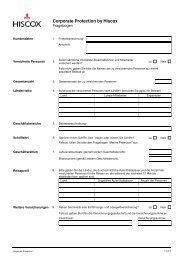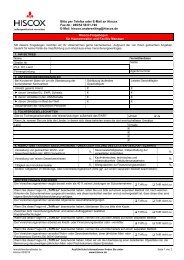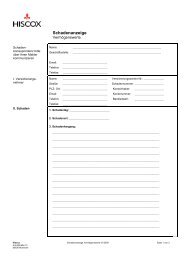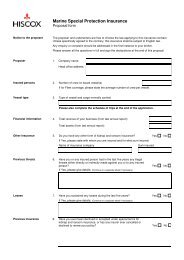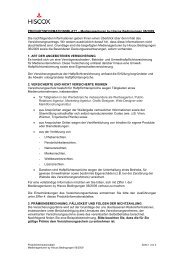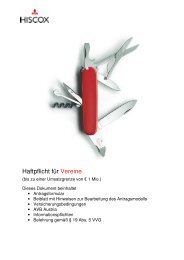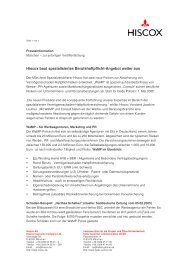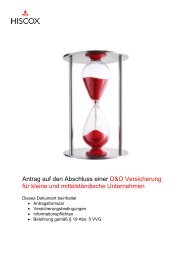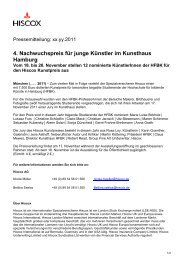Download PDF - Hiscox
Download PDF - Hiscox
Download PDF - Hiscox
You also want an ePaper? Increase the reach of your titles
YUMPU automatically turns print PDFs into web optimized ePapers that Google loves.
Notes to the consolidated<br />
financial statements<br />
continued<br />
3 Management of risk continued<br />
3.2 Financial risk continued<br />
(e) Currency risk<br />
The Group operates internationally and its exposures to foreign exchange risk arise primarily with respect to the US Dollar, Pound Sterling<br />
and the Euro. These exposures may be classified in two main categories:<br />
1) Structural foreign exchange risk through consolidation of net investments in subsidiaries with different functional currencies<br />
within the Group results; and<br />
2) Operational foreign exchange risk through routinely entering into insurance, investment and operational contracts, as a Group<br />
of international insurance entities serving international communities, where rights and obligations are denominated in currencies<br />
other than each respective entity's functional currency.<br />
The Group’s exposure to structural foreign exchange risk primarily relates to the US Dollar net investments made in its domestic operation<br />
in Bermuda and its overseas operation in Guernsey and the US. Other structural exposures also arise on a smaller scale in relation to net<br />
investments made in European operations. The Group’s risk appetite permits the acceptance of structural foreign exchange movements<br />
within defined aggregate limits and exchange rate parameters which are monitored centrally. Exchange rate derivatives are used when<br />
appropriate to shield the Group against significant movements outside of a defined range.<br />
At a consolidated level, the Group is exposed to foreign exchange gains or losses on balances held between Group companies where<br />
one party to the transaction has a functional currency other than Pound Sterling. To the extent that such gains or losses are considered<br />
to relate to economic hedges and intragroup borrowings, they are disclosed separately in order for users of the financial statements<br />
to obtain a fuller understanding of the Group’s financial performance (note 14).<br />
Up to 6 May 2008 the Group financed a portion of its net investment in the Bermuda and Guernsey insurance operations using US Dollar<br />
borrowings to which hedge accounting was applied (see note 20). There were no items qualifying for hedge accounting in the current year.<br />
The Group has the ability to draw on its current borrowing facility in any currency requested, enabling the Group to match its funding<br />
requirements with the relevant currency.<br />
Operational foreign exchange risk is controlled within the Group’s operations. The assets of the Group’s overseas operations are<br />
generally invested in the same currencies as their underlying insurance and investment liabilities producing a natural hedge. Due<br />
attention is paid to local regulatory solvency and risk based capital requirements.<br />
Details of all foreign currency derivative contracts entered into with external parties are given in note 22. All foreign currency derivative<br />
transactions with external parties are managed centrally. Included in the tables below are net non-monetary liabilities of £240 million<br />
(2008: £225 million) which are denominated in foreign currencies.<br />
As a result of the accounting treatment for non monetary items, the Group may also experience volatility in its income statement during<br />
a period when movements in foreign exchange rates fluctuate significantly. In accordance with IFRS, non monetary items are recorded at<br />
original transaction rates and are not remeasured at the reporting date. These items include unearned premiums, deferred acquisition costs<br />
and reinsurers’ share of unearned premiums. Consequently, a mismatch arises in the income statement between the amount of premium<br />
recognised at historical transaction rates, and the related claims which are retranslated using currency rates in force at the reporting date.<br />
The Group considers this to be a timing issue which can cause significant volatility in the income statements. Further details of the impact<br />
of the accounting treatment is provided in note 13.<br />
The currency profile of the Group’s assets and liabilities is as follows:<br />
At 31 December 2009<br />
Sterling<br />
£000<br />
US Dollar<br />
£000<br />
Euro<br />
£000<br />
Other<br />
£000<br />
Total<br />
£000<br />
Intangible assets 44,105 6,308 – – 50,413<br />
Property, plant and equipment 13,678 7,893 673 – 22,244<br />
Investments in associates 6,728 – 590 – 7,318<br />
Deferred tax – 14,077 – – 14,077<br />
Deferred acquisition costs 42,376 71,678 23,125 4,326 141,505<br />
Financial assets carried at fair value 580,797 1,623,276 166,629 42,598 2,413,300<br />
Reinsurance assets 54,976 320,424 27,375 17,351 420,126<br />
Loans and receivables including insurance receivables 127,361 259,539 88,480 13,402 488,782<br />
Current tax – – – – –<br />
Cash and cash equivalents 93,096 97,754 57,998 10,799 259,647<br />
Total assets 963,117 2,400,949 364,870 88,476 3,817,412<br />
68 Notes to the consolidated financial statements <strong>Hiscox</strong> Ltd Report and Accounts 2009




